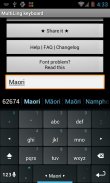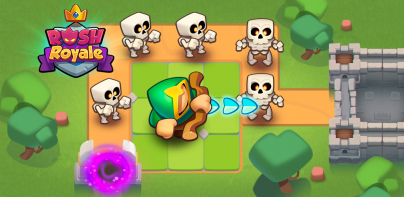




Maori Keyboard Plugin

Descrição do Maori Keyboard Plugin
Maori Dictionary plugin for Multiling O Keyboard autocorrect and word prediction
Instruction:
⑴ Install this plugin and Multiling O Keyboard. https://play.google.com/store/apps/details?id=kl.ime.oh
⑵ Run O Keyboard and follow its setup guide.
⑶ Slide space bar to switch languages.
If you have font issue, read this: http://honsoapps.appspot.com/1/ma.html
Wikipedia:
Maori or Māori (/ˈmaʊri/; Māori pronunciation: [ˈmaː.ɔ.ɾi]) is an Eastern Polynesian language spoken by the Māori people, the indigenous population of New Zealand. Since 1987, it has been one of New Zealand's official languages. It is closely related to Cook Islands Māori, Tuamotuan, and Tahitian.
According to a 2001 survey on the health of the Māori language, the number of very fluent adult speakers was about 9% of the Māori population, or 30,000 adults.[1] A national census undertaken in 2006 says that about 4% of the New Zealand population,[4] or 23.7% of the Maori population could hold a conversation in Maori about everyday things
Name
The English word comes from the Maori language, where it is spelled "Māori". In New Zealand the Maori language is commonly referred to as Te Reo [tɛ ˈɾɛ.ɔ] "the language", short for te reo Māori.
The spelling "Maori" (without macron) is standard in English outside New Zealand in both general[6] and linguistic[7] usage. The Maori-language spelling "Māori" (with macron) has become common in New Zealand English in recent years, particularly in Maori-specific cultural contexts,[8][9] although the traditional English spelling is still prevalent in general media and government use.[10][11]
Preferred and alternate pronunciations in English vary by dictionary, with /ˈmaʊəri/ being most frequent today, and /mɑːˈɒri/, /ˈmɔri/, and /ˈmɑri/ also given.[12] Spelling pronunciations as /meɪˈɔəri/ are also encountered in popular speech[13][14] in the United States particularly, but are considered incorrect.
Official status
New Zealand has three official languages – English, Māori and New Zealand Sign Language.[15] Māori gained this status with the passing of the Māori Language Act in 1987.[16] Most government departments and agencies have bilingual names; for example, the Department of Internal Affairs Te Tari Taiwhenua, and places such as local government offices and public libraries display bilingual signs and use bilingual stationery. New Zealand Post recognises Māori place-names in postal addresses. Dealings with government agencies may be conducted in Māori, but in practice, this almost always requires interpreters, restricting its everyday use to the limited geographical areas of high Māori fluency, and to more formal occasions, such as during public consultation.
An interpreter is on hand at sessions of Parliament, in case a Member wishes to speak in Māori. In 2009, Opposition parties held a filibuster against a local government bill, and those who could recorded their voice votes in Māori, all faithfully interpreted.[17]
A 1994 ruling by the Privy Council[18] in the United Kingdom held the New Zealand Government responsible under the Treaty of Waitangi (1840) for the preservation of the language. Accordingly, since March 2004, the state has funded Māori Television, broadcast partly in Māori. On 28 March 2008, Māori Television launched its second channel, Te Reo, broadcast entirely in the Māori language, with no advertising or subtitles. In 2008, Land Information New Zealand published the first list of official place names with macrons, which indicate long vowels. Previous place name lists were derived from systems (usually mapping and GIS systems) that could not handle macrons
</div> <div jsname="WJz9Hc" style="display:none">Maori dicionário plugin para MultiLing O autocorrect Teclado e previsão de palavras
Instrução:
⑴ Instale este plugin e MultiLing O Teclado. https://play.google.com/store/apps/details?id=kl.ime.oh
⑵ Run O Teclado e seguir o seu guia de configuração.
⑶ barra de espaço Deslize para alternar entre idiomas.
Se você tem problema de fonte, leia isto: http://honsoapps.appspot.com/1/ma.html
Wikipedia:
Maori ou Maori (/ maʊri /; Maori Pronúncia: [maː.ɔ.ɾi]) é uma língua polinésia Oriental falada pelo povo Maori, a população indígena da Nova Zelândia. Desde 1987, tem sido uma das línguas oficiais da Nova Zelândia. Ele está intimamente relacionado com Ilhas Cook Māori, Tuamotuan, e Tahitian.
De acordo com uma pesquisa de 2001 sobre a saúde do idioma Maori, o número de falantes adultos muito fluentes foi de cerca de 9% da população Maori, ou 30.000 adultos. [1] Um censo nacional realizado em 2006 diz que cerca de 4% do Novo população Zelândia [4], ou 23,7% da população Maori poderia manter uma conversa em maori sobre coisas cotidianas
Nome
O Inglês palavra vem da língua maori, onde está escrito "Maori". Na Nova Zelândia, a língua maori é comumente referido como Te Reo [tɛ ɾɛ.ɔ] "a língua", abreviação de te reo Maori.
A ortografia "Maori" (sem macron) é padrão em Inglês fora da Nova Zelândia, tanto geral [6] e linguística [7] uso. A ortografia do idioma Maori "Maori" (com macron) tornou-se comum na Nova Zelândia Inglês nos últimos anos, particularmente em contextos culturais específicos-Maori, [8] [9], embora a ortografia tradicional Inglês ainda é predominante na mídia em geral e governo utilização. [10] [11]
Preferido e pronúncias de suplentes em Inglês variam de acordo com dicionário, com / maʊəri / ser mais freqüente hoje, e / mɑːɒri /, / mɔri /, e / mɑri / também dado. [12] pronúncias de ortografia como / meɪɔəri / também são encontradas na fala popular [13] [14] nos Estados Unidos em particular, mas são considerados incorrectos.
Estatuto oficial
A Nova Zelândia tem três línguas oficiais - Inglês, Maori e Nova Zelândia Sign Language [15] Maori ganhou esse status com a aprovação da Lei de Língua Maori em 1987. [16] A maioria dos departamentos e agências do governo têm nomes bilíngües.; por exemplo, o Departamento de Assuntos Internos Te Tari Taiwhenua, e lugares como escritórios do governo local e bibliotecas públicas exibir sinais bilíngües e usar papel de carta bilíngüe. Nova Zelândia Pós reconhece topónimos Maori em endereços postais. Relações com as agências governamentais podem ser conduzidas em Maori, mas, na prática, isso quase sempre requer intérpretes, restringindo seu uso diário para as áreas geográficas limitadas de alta fluência Maori, e para ocasiões mais formais, como durante a consulta pública.
Um intérprete está à disposição nas sessões do Parlamento, no caso um membro pretenda falar em maori. Em 2009, os partidos de oposição realizou um filibuster contra um projeto de lei do governo local, e aqueles que poderiam registraram seus votos de voz em Maori, todos fielmente interpretado. [17]
A decisão de 1994 pelo Conselho [18] Privy no Reino Unido realizou o Governo da Nova Zelândia responsável no âmbito do Tratado de Waitangi (1840) para a preservação da língua. Assim, desde Março de 2004, o Estado financiou Maori Television, transmitido em parte em maori. Em 28 de março de 2008, Maori Television lançou seu segundo canal, Te Reo, transmitido inteiramente na língua Maori, sem publicidade ou legendas. Em 2008, Informações sobre o terreno Nova Zelândia publicou a primeira lista de nomes de lugares oficiais com macrons, que indicam vogais longas. Listas nome da cidade anterior foram derivadas de sistemas (geralmente mapeamento e sistemas GIS) que não poderia lidar com macrons</div> <div class="show-more-end">
























